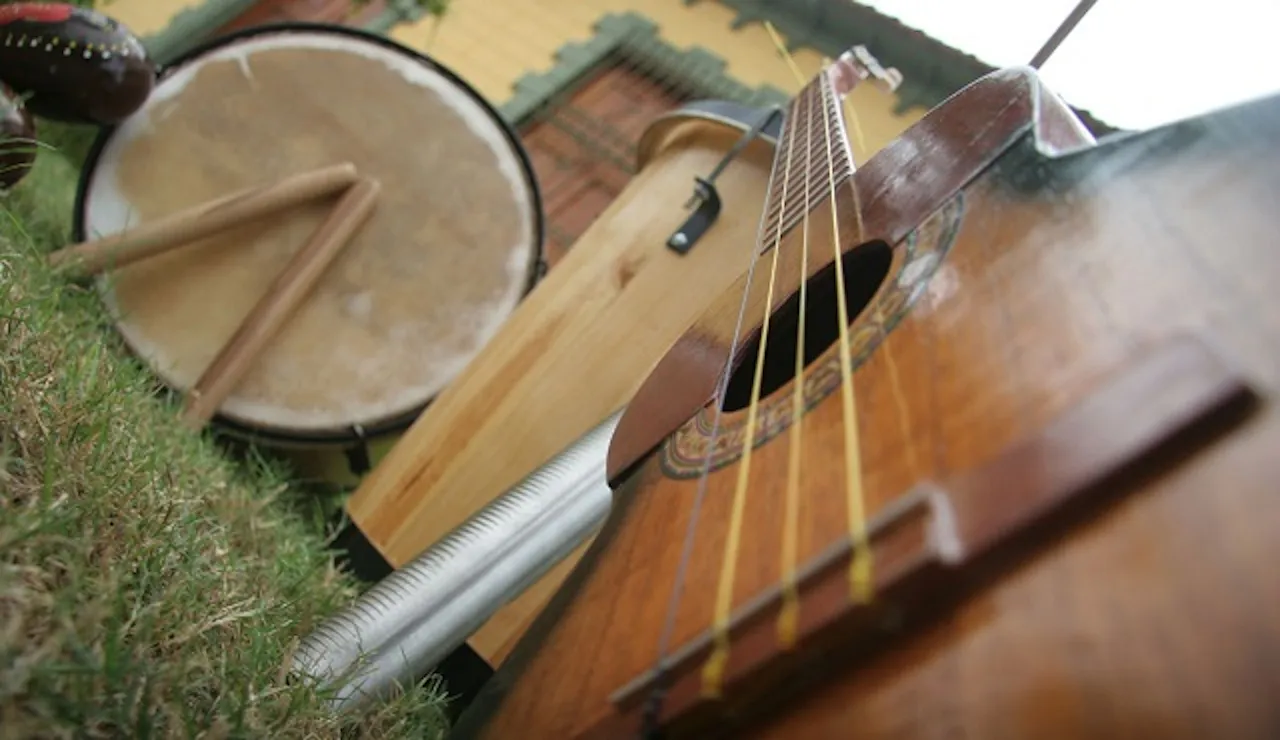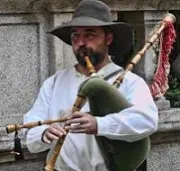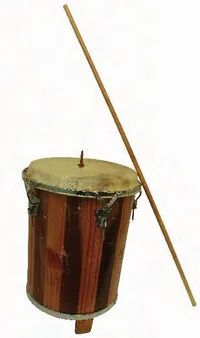
On several occasions I have published content talking about one of the musical genres associated with Christmas in Venezuela or I have posted songs with this rhythm, the gaita (bagpipe). It is also called the Queen of Folklore, due to its great acceptance at a national level.
Although this is a confusion that arises many times, in this opportunity I am responding to @nikalaich, who left his comment in my most recent gaita Melodía gaitera.
There is one element that calls a lot of attention to this music: its name.
¡Versión en español más abajo!
The bagpipe, as an instrument
Bagpipe (in Spanish Gaita) is the name of a musical instrument known mainly for its Scottish version. However, it is important to note that this is an instrument of very ancient origin used by the Babylonians and Phoenicians, among others, which is believed to have been used by armies to, with that sound, scare off enemies.
Although the instrument arrived in Celtic lands and has become popular as a Scottish instrument, actually where it has had greater development is in Spain, where it arrived during the middle evo through Zamora. Subsequently, and as a result of this, the Galician and Asturian bagpipes were born, which continue to have a great presence in the cultural activity of these regions today.
With the Spanish conquest of American lands, there were many instruments brought by the colonizers for their own entertainment, and no doubt some bagpipes must have come, among these.
A party in the west
With the arrival of the African slaves to our lands, a mixture was completed that gave birth to what we are as a nation, a combination of indigenous people, with Spaniards and Africans. The festivities and celebrations began to result in an integration of different elements of those three origins. The Christian religion, imposed by iron and blood, was filled with indigenous and African references and so were their festivals and celebrations.
In the west of the country, San Benito de Palermo (Benedict the Moore) and Santa Lucia (Saint Lucy) were venerated in large sectors and for the celebrations they used to sing melodies born from this interculturality.
In these songs, melodies were combined, many times with Spanish roots (but with the alternation choir-solo of African origin), guitars or the same cuatro which is a version of a small four-string guitar born in Venezuela, but also with its Spanish origin, and one of the outstanding instruments of this music, which came also from Spain, the zambomba, which is known in Venezuela as furruco or furro in the state of Zulia; with instruments of African origin, such as the drum kit used in the South of Lake Maracaibo, in the Chimbángueles. And the indigenous element is present in the use of maracas and various types of flute, mainly of guajiro or wayuu origin. One of the most popular and was involved in the celebrations of San Benito, was a flute known as Wotoroyo or Sawawa, with a sound very similar to the bagpipe, the instrument brought by the Spanish.
In this demonstration made by the great Venezuelan musician Lester Paredes, you ca hear in the minute 1:48 the sound of this ancestral flute.
Sawawa - Lester Paredes
The presence of this instrument was so important in that celebration that over the years, with the disappearance of many traditional instruments, it was replaced in the festivities by a clarinet and today is still a fundamental part in the celebration of the saint.
In the song Colina we can hear the role that this instrument plays, which supports the choir and performs single melodies.
Colina - Candela Group
But, in spite of having a religious inspiration, most of these musical forms did not "enter" the church, that is to say, they were not integrated into the worship. For that very reason it was considered more of a festive music.
In those parties, of course, not only one rhythm was played, but there was a variety and people, depending on the area, preferred some rhythms more than others.
And the bagpipes?
Researchers as serious and responsible as the musicologist Luis Felipe Ramón y Rivera, had the theory that people associated the sound of the wotoroyo, mentioned above, with the bagpipe and that the expression "here comes the bagpipe" or "the bagpipe is in the square" became popular, to refer to the celebration where they were playing the music with the guajiro instrument and that later, although that instrument was no longer there, the custom remained of associating the celebration with the name of the bagpipe.
Among the different rhythms that were developed in these parties, only one of them maintains the sound of the instrument that generated the name, is the variant that is sung in the South of the Lake, specifically in the area of Bobures and that we now know as "Gaita de Tambora" (Drum Gaita). In the other variants, even though they did not use that type of instrument, the name also remained, because of the explanation I gave earlier. Thus, in addition to the one named above, there is also the "Gaita de Santa Lucia," which rhythmically resembles more what we now call the tamborera.
Gaita a Santa Lucia - Candela Group
Perhaps the least known of these variants is the so-called "Gaita Perijanera" (from the city of Perijá).
Here I share this and for all samples that I leave you here, I am placing the group Candela, which is an extraordinary group that is dedicated to the investigation of the folklore of the west of the country, emphasizing the music of the state of Zulia.
Gaita perijanera - Candela Group
Finally, there is the variant that has had the greatest receptivity on a national level and has become a musical genre played throughout the country and one of the favorites of the Christmas season, which is called "Gaita de Furro" or just "Gaita".
Del Empedrao venimos (From the Empedrao we come) - Candela Group
For this reason, in the case of Venezuela, the word gaita has no translation, since the term refers to a specific musical form that has no relation whatsoever to the wind instrument. However, you will certainly find many posts that deal with our gaita and you will see the term translated as the instrument, because as I said in a previous post, machine translators do not know many things, that humans do...

Español

En varias oportunidades he publicado contenido hablando sobre uno de los géneros musicales asociados a la navidad en Venezuela o he publicado canciones con este ritmo, la gaita. Llamada también la Reina del Folclor, debido a su gran aceptación a nivel nacional.
Aunque esta es una confusión que surge muchas veces, en esta oportunidad le estoy respondiendo a @nikalaich, quien dejó su comentario en mi más reciente gaita Melodía gaitera.
Hay un elemento que llama mucho la atención de esta música: su nombre.
La gaita, como instrumento
Gaita es el nombre de un instrumento musical conocido principalmente por su versión escocesa. Sin embargo es importante destacar que este es un instrumento de origen muy antiguo usado por babilonios y fenicios, entre otros, del cual se cree que era utilizado por los ejércitos para, con ese sonido, asustar a los enemigos.
Aunque el instrumento llegó a tierras celtas y se ha popularizado como instrumento escocés, realmente donde ha tenido mayor desarrollo es en España, a donde llegó durante el medio evo a través de Zamora. Posteriormente y a raíz de esta, nace la gaita gallega y la asturiana, las cuales siguen teniendo hoy en día una gran presencia en la actividad cultural de esas regiones.
Con la conquista española de tierras americanas, fueron muchos los instrumentos que trajeron los colonizadores para su entretenimiento propio y sin duda debe haber venido alguna gaita, entre estos.
Una fiesta en el occidente
Con la llegada de los esclavos africanos a nuestras tierras se terminó de completar una mezcla que dio origen a lo que somos como nación, una combinación de indígenas, con españoles y africanos. Las fiestas y celebraciones empezaron a dar como resultado una integración de distintos elementos de esos tres orígenes. La religión cristiana, impuesta a hierro y sangre, se llenó de referencias indígenas y africanas y así también sus fiestas y celebraciones.
En el occidente del país se veneraba en grandes sectores a San Benito de Palermo y a Santa Lucía y para las celebraciones solían cantar melodías nacidas de esta interculturalidad.
En estos cantos se combinaban melodías, muchas veces de raíz española (pero con la alternancia coro-solista de origen africano), guitarras o el mismo cuatro que es una versión de pequeña guitarra de cuatro cuerdas nacido en Venezuela, pero también con su origen español, y uno de los instrumentos destacados de esta música, que es de origen español, la zambomba, que se conoce en Venezuela como furruco o furro en el estado Zulia; con instrumentos de origen africano, como la batería de tambores usada en el Sur del Lago de Maracaibo, en los chimbángueles. Y el elemento indígena se hace presente en el uso de las maracas y de varios tipos de flauta, principalmente de origen guajiro o wayuu. Una de las más populares y que se hacía partícipe en las celebraciones de San Benito, era una flauta conocida como Wotoroyo o Sawawa, con una sonoridad muy parecida a la gaita, el instrumento traído por los españoles.
En esta demostración hecha por el gran músico venezolano Lester Paredes, puedes escuchar en el minuto 1:48 el sonido de esta flauta ancestral.
Sawawa – Lester Paredes
La presencia de este instrumento era tan importante en esa celebración, que con el paso de los años, con la desaparición de muchos instrumentos tradicionales, este fue sustituido en las fiestas por un clarinete y hoy en día sigue siendo parte fundamental en la celebración del santo.
En la canción Colina podemos escuchar el papel que cumple este instrumento, el cual apoya al coro y realiza melodías sueltas.
Colina – Grupo Candela
Pero, a pesar de tener una inspiración religiosa, la mayor parte de estas formas musicales no “entraban” a la iglesia, es decir no estaban integradas al culto. Por esa misma razón era más bien considerada música de fiesta.
En esas fiestas, por supuesto, no se interpretaba un solo ritmo, sino que había una variedad y la gente, según la zona que se encontraba, prefería más unos ritmos que otros.
¿Y la gaita?
Investigadores tan serios y responsables como el musicólogo Luis Felipe Ramón y Rivera, tenían la teoría de que la gente asociaba el sonido del wotoroyo, antes mencionado, con la gaita y que se popularizó la expresión “ahí viene la gaita” o “la gaita está en la plaza”, para referirse a la fiesta donde estaban tocando la música con el instrumento guajiro y que luego, aunque ya no estuviera ese instrumento, quedó la costumbre de asociar la fiesta con el nombre de gaita.
Entre los distintos ritmos que se desarrollaron en estas fiesta, solo uno de ellos mantiene el sonido del instrumento que generó el nombre, es la variante que se canta en el Sur del Lago, específicamente en la zona de Bobures y que ahora conocemos como “Gaita de Tambora”. En las otras variantes, aunque no usara ese tipo de instrumento, también quedó el nombre, por la explicación que di antes. Es así como además de la nombrada anteriormente, también hay la “Gaita de Santa Lucia”, que rítmicamente se parece más a lo que ahora llamamos tamborera.
Gaita a Santa Lucía – Grupo Candela
Quizá la menos conocida de estas variantes es la llamada “Gaita Perijanera” (de la ciudad de Perijá).
Aquí les comparto esta y para todas muestras que aquí les dejo, estoy colocando al grupo Candela, que es una extraordinaria agrupación que se dedicó a la investigación del folclor del occidente del país, haciendo énfasis en la música del estado Zulia.
Gaita perijanera – Grupo Candela
Finalmente está la variante que ha tenido mayor receptividad a nivel nacional y se ha convertido en un género musical interpretado en todo el país y uno de los preferidos de la época navideña, que lleva el nombre de “Gaita de Furro”, o simplemente "Gaita".
Del Empedrao venimos – Grupo Candela
Por eso, en el caso de Venezuela, la palabra gaita no tiene traducción, pues el término se refiere a una forma musical específica que no tiene relación alguna con el instrumento de viento. Sin embargo, con toda seguridad vas a encontrar muchas publicaciones que traten de nuestra gaita y veas el término traducido como el instrumento, porque tal como lo dije en un post anterior, los traductores automáticos no saben muchas cosas, que los humanos sí…

Source of the main image |Fuente de la imagen principal

Music community logo by @ikasumanera | Banner by @equipodelta


@ylich
http://ylich.com
https://sptfy.com/ylich
If you don't have an account at Hive yet, I invite you to read my post My Hive Testimony || Mi testimonio Hive
Si aún no tienes cuenta en Hive te invito a leer mi publicación My Hive Testimony || Mi testimonio Hive


